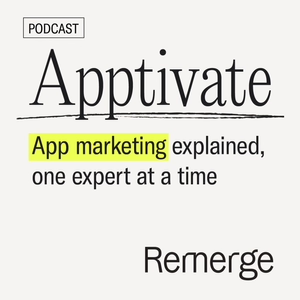
Apptivate: App Marketing Explained
Remerge
All episodes
Best episodes
Top 10 Apptivate: App Marketing Explained Episodes
Goodpods has curated a list of the 10 best Apptivate: App Marketing Explained episodes, ranked by the number of listens and likes each episode have garnered from our listeners. If you are listening to Apptivate: App Marketing Explained for the first time, there's no better place to start than with one of these standout episodes. If you are a fan of the show, vote for your favorite Apptivate: App Marketing Explained episode by adding your comments to the episode page.
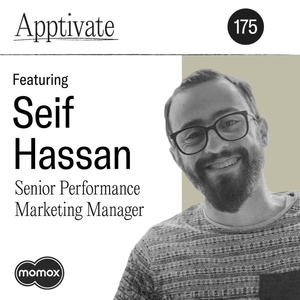
Acquisition Strategies to Beat Seasonal Dips - Seif Hassan (Momox)
Apptivate: App Marketing Explained
02/21/24 • 15 min
Sometimes e-commerce apps will notice changes in user behavior that correlate to the time of year. What can app marketers do to incentivize their users to take action during these periods? Find out in this episode of Apptivate’s e-commerce series, featuring Seif Hassan, the Senior Performance Marketing Manager for the inbound unit at Momox.
Momox is a Berlin-based “recommerce” company that buys and resells used books and media. Previous to working at Momox, Seif led user acquisition efforts for apps across global markets, including Phiture, Quandoo, and Wego.com.
Questions Seif Answered in this Episode:
- Tell us about Momox.
- What’s your role at Momox?
- How do you manage acquisition for both the inbound and outbound sides of your marketplace?
- How do you incentivize people to sell their belongings on your app?
- Where are you looking to expand?
- How do you evaluate the media channels that you’re working with to support acquisition or retention as you expand to new countries?
- Are you experimenting with AI?
- Do you have any predictions for our industry in 2024?
Timestamp:
- 0:47 About Momox
- 1:37 Seif’s role at Momox
- 3:42 Marketplace seasonality
- 7:15 Incentivizing users with bonuses in their checkout cart
- 7:51 Expansion as a strategy to overcome seasonality barriers
- 11:52 Experimenting with tone of voice with AI
- 13:00 Looking ahead
Quotes:
(8:20-8:34) “Expansion is one of the ways in which we try to conquer this seasonality problem. It also helps with acquiring books in different languages and expanding our inventory, and therefore, our customer base.”
(11.48-12.16) “We have experimented with AI for some of the ad texts for the tone of voice that we are using in order to see how can we try a different communication approach, and AI comes in very handy, especially if you have limited capacity or limited resources to produce as many creatives as possible.”
Mentioned in this Episode:
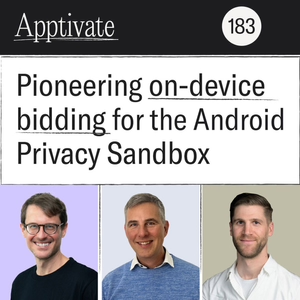
Pioneering On-device Bidding for the Android Privacy Sandbox - Trenton Starkey (Google), Gaylord Zach (Verve Group), Pan Katsukis (Remerge)
Apptivate: App Marketing Explained
06/12/24 • 31 min
How will mobile demand-side platforms (DSPs) and supply-side platforms (SSPs) bid on and sell ad placements via Google’s Privacy Sandbox for Android? Find out as Remerge’s CEO and Co-founder, Pan Katsukis, interviews Verve Group’s Head of Mobile Product, Gaylord Zach, and Google’s Android Privacy Sandbox’s Product Manager for the Protected Audience API, Trenton Starkey. Mobile advertisers and publishers can learn about the all-new on-device auction system, how it works, and how they can prepare for the rollout of the Android Privacy Sandbox.
Questions Answered in this Episode:
- What is Verve Group’s approach to the Privacy Sandbox? And what led you to become one of the first SSPs in the industry to test the auction system?
- How is early testing of the Protected Audience API going?
- Can you describe the on-device bidding test between Verve and Remerge?
- How did the test work? What challenges were there in the implementation and testing? How are you solving these challenges?
- How can advertisers and publishers prepare for the rollout of Android’s Privacy Sandbox?
Timestamp:
- 0:26 Today's Topic: Privacy Sandbox
- 1:22 Meet the Guests: Trenton Starkey and Gaylord Zach
- 2:16 Verve Group’s approach to Privacy Sandbox
- 5:28 Why Google is collaborating with the industry to build the Privacy Sandbox
- 10:27 The importance of early testing of Android’s Protected API
- 12:55 Recap of Verve and Remerge’s on-device bidding test
- 20:09 Next steps: What’s changing for publishers and advertisers?
- 33.48 Final thoughts
Quotes:
28:26 - Pank Katsukis: ”These milestones for the Privacy Sandbox are the foundations for setting up, running and scaling campaigns in the privacy-first era.”
31:40 - Trenton Starkey: ”Now is the time to work on our privacy-focused solutions. It’s a great opportunity to rethink how advertisers and publishers can keep delivering great experiences.”
34:56 - Gaylord Zach: ”By having powerful technologies at hand, we can really develop advertising products that allow us to reach the right audiences.”
Mentioned in this Episode:
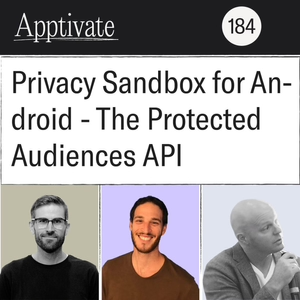
Privacy Sandbox for Android: The Protected Audiences API - John Koetsier (Growth Masterminds), Luckey Harpley (Remerge), Omri Gal (Singular)
Apptivate: App Marketing Explained
06/26/24 • 29 min
This week, we bring you an episode from Singular’s Growth Masterminds Podcast about what targeting and retargeting will look like for mobile marketers on the Android Privacy Sandbox, featuring Luckey Harpley (Remerge’s Principal Product Manager), Omri Gal (Singular’s Head of Privacy), and host John Koetsier. Learn about the initial testing and campaigns that Remerge has run with Singular’s new SDK for the Sandbox’s Protected Audiences API – and find out what to expect when the rollout takes place.
Questions answered in this episode:
- What is the Protected Audiences API?
- What’s the function of the protected apps signal API?
- How is this related to the Topics API?
- How will targeting work with the Privacy Sandbox?
- How will retargeting work with Privacy Sandbox?
- Tell us about Singular’s testing of the Privacy Sandbox
- How does retargeting work when user data stays on the device?
- How can app marketers prepare for this?
Timestamp:
- 1:25 What’s new with the Privacy Sandbox?
- 3:46 What is the Protected Audiences API?
- 5:15 How does the Protected Apps Signal API work?
- 6:30 Is it a better Topics API?
- 10:56 What will targeting look like with the Privacy Sandbox?
- 12:45 What will retargeting look like with the Privacy Sandbox?
- 17:20 Testing Singular’s SDK with the Privacy Sandbox
- 23:00 How retargeting can work with on-device data
- 24:20 How can mobile marketers prepare for the Privacy Sandbox?
Quotes:
(3:47-4:00) “The Protected Audiences API started off its life as an API focused on solving the retargeting problem, but it’s become a lot more than that. I think remarketing will, in the end, be a small part of it.”
(23:00-23:26) “It’s not that all information lives on the device, but rather, all the information that can track a user across apps lives on the device. So our advertisers will still be able to track with their MMP partners. They just won’t know which users are in app A, B, C – but they’ll still know what users are doing in app A – and what they’re doing in app B and C. They just won’t be able to connect them together.”
Mentioned in this Episode:
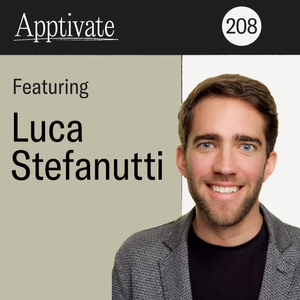
Going the distance: Growth lessons from adidas Running - Luca Stefanutti (adidas Running)
Apptivate: App Marketing Explained
05/14/25 • 29 min
In this episode, we chat with Luca Stefanutti, the Director of Growth at adidas Running, the fitness app formerly known as Runtastic. They touch on the app’s role within the larger brand, key performance metrics, implementing new insights within large teams, and Luca’s point of view on some of today’s hottest app marketing topics, like AI, creatives, and the relationship between incremental and organic traffic.
Questions Luca answered in this episode:
- What is Runtastic and what is your role there?
- How has your background informed your role today?
- What role does adidas Running play in the brand’s larger digital ecosystem?
- What key metrics does your team look at when evaluating performance?
- Can you tell me about an experiment you ran that had surprising results?
- How do you put the insights you gain from experiments into action?
- How are you going about personalization in a cookieless, post-IDFA world?
- What trends are you watching that you think will shape the future of app marketing?
Timestamp:
- 0:47 Intro to adidas Running
- 3:10 Luca’s background
- 5:20 The role of adidas Running for the larger brand
- 7:35 Key metrics
- 10:30 Surprising learnings
- 13:00 Implementing new insights into action
- 15:04 Creative strategy for growth & UA
- 17:30 Personalization in a post-IDFA world
- 19:48 Thoughts on current app marketing trends
- 25:58 What to do in Austria for a few days?
Quotes:
(12:30-12:45) “I think the learning here is that you generally have one core value proposition for your app. Don’t forget about it with all the extra features. Just make sure you connect people to the core value.”
(13:45-14:02) “In terms of growth, picking one person from relevant teams to form a cross-functional squad will make sure that all your ideas are developed and spread around.”
Mentioned in this Episode:
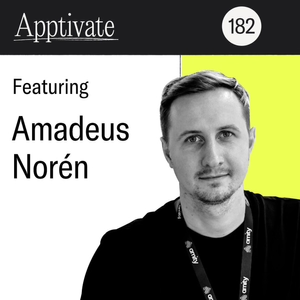
Building Your In-App Community - Amadeus Norén (Amity)
Apptivate: App Marketing Explained
05/29/24 • 26 min
Amadeus Norén is the Director of Product Marketing at Amity. Amity’s platform provides customizable SDKs for every social feature imaginable so that app-based businesses can launch, grow, and monetize their in-app social community. In this episode, you’ll learn how to leverage this community, and why not doing so could be a missed opportunity for your brand.
Questions Amadeus Answered in this Episode:
- Why should businesses consider moving away from social media platforms to build their communities within their apps?
- Why is it important for apps to own the user data of their social network?
- How can apps monetize their in-app communities?
- How can you use the customer feedback collected from the conversations of your in-app community?
- Does Amity’s platform address the challenges companies are facing right now?
- What does your day-to-day look like when marketing Amity’s products?
- Can apps track revenue or user engagement generated from within their in-app community?
Timestamp:
- 0:49 Amadeus’s background
- 1:27 What is Amity?
- 4:32 The decline of Facebook group organic reach
- 5:43 Why build your community within your app?
- 7:44 How to monetize your in-app community
- 9:17 Use cases for collected customer feedback
- 11:40 Amity’s AI tool
- 14:24 Marketing Amity’s products
- 17:13 Evaluating the performance of Amity’s platform
- 19:17 User expectations for social networks
- 22:23 What’s Amadeus excited about in the future
Quotes:
(4:42-5:01) “Ten years ago, your organic reach for a Facebook page was 20 to 15 percent. Currently, the organic reach for all of the following that you’ve built up on your Facebook page is one percent. So in order to reach your audience, you now need to pay for ads to reach those people.”
(9:37-9:46) “You can take all of the data from conversations that are happening in your in-app community, analyze it with AI, and make smarter decisions for the future.”
Mentioned in this Episode:
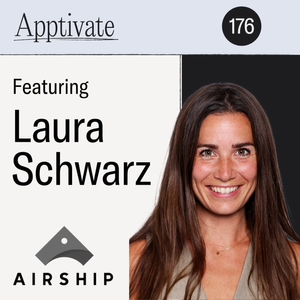
Women in Mobile: Closing the Tech Industry’s Gender Gap - Laura Schwarz (Airship)
Apptivate: App Marketing Explained
03/08/24 • 34 min
It’s difficult to find female talent in the tech industry, and it’s a real problem. Apptivate’s Women in Mobile series is back this March to celebrate Women’s History Month and to discuss how to close the gender gap in our industry. In this episode, Maria chats with Laura Schwarz, Airship's Senior Director of Sales for EMEA, who joined a handful of other female tech leaders in launching a program that invites young girls and boys to learn about different jobs within tech companies. To date, the NOW+NEXT program has reached over 6,000 young girls throughout the UK with plans to expand to the U.S.
Questions Laura Answered in this Episode:
- What led you to where you are in your career today?
- How do we encourage women to break into our industry?
- What has excited or inspired some of the girls who’ve gone through our internship?
- Can you tell us about your career story and also introduce Airship to our listeners?
- What makes you excited to be working in your current role?
- Do you have any advice for our listeners?
Timestamp:
- 1:10 Laura’s background
- 5:10 The effect of “bro culture”
- 6:50 Women are still underrepresented in tech
- 8:09 Introducing tech careers to girls
- 14:30 NOW+NEXT
- 16:10 We won’t want men “out of the room”
- 18:12 What helps get young people excited about tech careers?
- 21:42 About Airship and Laura’s role
- 26:55 The forefront of innovation
- 29:28 Career advice for young listeners
Quotes:
(8:40-9:03) “I get 50 applications from male candidates and one female. How is that? Where are the women applying for jobs? This is a real problem, and we have to find a solution to that.”
(15:15-15:30) “I think that’s what a lot of women in different areas of business and research are doing – they’re paving the way and they’re always asking, ‘What’s next?’ We’re not satisfied with the status quo.”
Mentioned in this Episode:
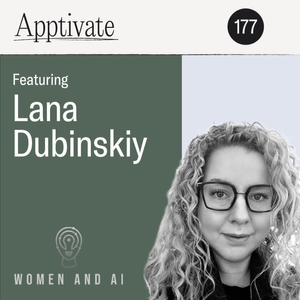
Women in Mobile: Boss Ladies Working in AI - Lana Dubinskiy (Women and AI)
Apptivate: App Marketing Explained
03/20/24 • 28 min
As part of our Women in Mobile series celebrating Women’s History Month, Maria Lannon from Remerge talks to Lana Dubinskiy, an AI product advisor and a co-founder of Women and AI. Women and AI is an initiative highlighting women working in the field of artificial intelligence and providing relevant industry news. It was created so that women could help each other shine within this male-dominated sector of the tech industry.
Questions Lana answered in this episode:
- How did you end up in product advertising? Did you have a mentor?
- Did you ever feel intimidated to speak up?
- How have you been able to get other women to join?
- Are there certain resources that you gravitate towards that have helped you?
- How do you prioritize your day to stay on top of things? How do you prioritize your “you” time?
- What is the best piece of advice you’ve received? And what is the worst?
Timestamp:
- 2:27 Lana’s background
- 4:02 Getting into male-dominated professions
- 5:57 Data points: How to speak with confidence
- 7:18 The creation of Women and AI
- 9:00 Get involved with Women and AI
- 11:40 Growing is uncomfortable
- 14:40 Staying on top of AI news
- 18:25 Compartmentalizing clients as a consultant
- 21:46 Work-life balance
- 24:52 The worst and best advice
Quotes:
(4:26-4:36) “I see a lot of people get to a certain level and they feel like they just want to be on top of the mountain by themselves. I think it’s so important, as women, to give back to our community and mentor other women.”
(8:00-8:23) “We went to conferences and there were only a few women there. We could have spoken at the conference – we had more knowledge than the presenters there. So it was very disheartening. We felt like this is something we can do: We can highlight other women. We can show boss ladies, CEOs, that are working in the AI space, dominating it, and really making an impact.”
Mentioned in this Episode:
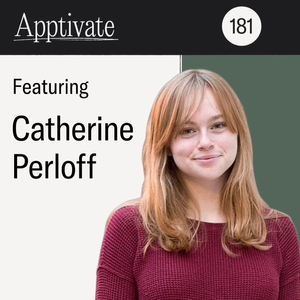
Inside the Mobile Marketing Industry’s No-ID world - Catherine Perloff (AdWeek)
Apptivate: App Marketing Explained
05/15/24 • 29 min
Catherine Perloff is the platforms reporter at Adweek, an American publication covering news related to the brand marketing ecosystem. In this episode, Catherine gives us the latest news on what’s happening within the murkiness of cookie depreciation and the advertising industry’s no-ID world. She also discusses emerging trends from AI-powered media buying to retail media and more.
At Adweek, Catherine focuses on how media buyers and brands spend their marketing budgets, what channels are most effective for them, and what struggles they encounter in buying the best media to reach the right audience. She also covers how publishers monetize effectively with digital marketing tools.
Questions Catherine answered in this episode:
- What does ‘platforms’ mean from the perspective of a marketing reporter?
- What's the feedback from the industry on Meta’s AI-powered Advantage+?
- Besides the impacts of privacy, what other trends do you foresee happening this year?
- How do you stay up-to-date on what’s happening in the marketing space?
Timestamp:
- 0:52 Catherine’s background
- 4:39 Unpacking the platforms
- 7:33 ATT’s impact on Meta for advertisers
- 11:00 The scoop on Meta’s AI-powered Advantage+
- 13:46 What’s happening in the no-ID world
- 15:45 The future of AI-driven media buying
- 17:10 Retail media and connected TV
- 21:25 ID bridging: shady business?
- 25:44 Resources
Quotes:
(7:39-7:59) “I think that there was a mindset that you could build a whole business on Meta, like that would be your main channel – and after ATT, I think a lot of businesses, especially DTC brands, realized they had to diversify.”
(15:01-15:20) “The purveyors of premium inventory are always going to say that high-quality inventory will be performative. I don’t think that’s true, but it’s definitely harder to prove. It’s often said that if you can’t track it, it’s branding.”
(16:47-17:07) “AI is being used for creativity in the advertising space. Is generative AI going to replace creative agencies? Is it going to replace copywriters? It poses a real existential threat to media agencies if more of the technology is doing the decision-making.”
Mentioned in this Episode:
- Catherine Perloff’s LinkedIn
- Email: [email protected]
- Twitter (X): @catherineperlo1
- Adweek
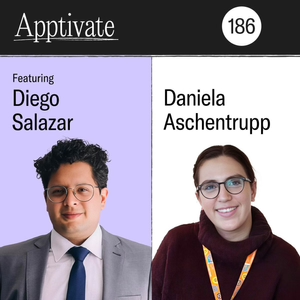
Driving Results: Full-Funnel Strategies for Mobile Marketing - Daniela Aschentrupp (DiDi), Diego Salazar (DiDi)
Apptivate: App Marketing Explained
07/24/24 • 28 min
In this episode, we speak to Diego Salazar, the Paid Media Lead, and Daniela ‘Dani’ Aschentrupp, the Ad Ops & Acquisitions Lead, at DiDi, one of the world’s biggest mobility and food delivery apps. Get a full-funnel perspective with best practices for re-engaging lapsed users and top tips for acquiring new ones. This episode also covers creative strategies and how to measure the effectiveness of your campaigns, along with a round-up of what to do in Mexico City!
Questions Diego and Dani answered in this episode:
- Dani, what’s one story about mobile marketing you have to share with our listeners from a global giant like DiDi?
- How do you measure brand campaigns?
- Diego, can you give us some tips on creative strategy for re-engagement?
- Do you have any favorite call-to-actions for re-engagement on the creative side?
- Dani, what are your tips for UA creative strategies?
- What best practices do you have to share about measurement for UA and retargeting?
- How do you re-engage dormant users?
- What are some of the biggest challenges you face when marketing to your customers?
- What predictions do you have for the Google Privacy Sandbox?
- What should I see in Mexico City?
Timestamp:
- 0:53 Intro to DiDi and the guests
- 2:12 Measuring the effectiveness of brand campaigns
- 6:03 Creative strategy tips for re-engagement
- 7:58 Creative strategy tips for UA
- 9:40 Measurement best practices for retargeting
- 13:26 Re-engaging lapsed users incrementally
- 14:51 What problem are you solving for your user?
- 17:25 Marketing challenges
- 20:28 Why a full-funnel approach to attribution is better
- 22:00 Predictions for Google’s Privacy Sandbox
- 24:17 What is there to do in Mexico City?
Quotes:
(6:40-6:53) - “Regarding creatives, it's very important to keep an updated pipeline with different ideas that you can continuously test to identify the top-performing message.”
(8:11-8:32) “You already know what works [for your creatives]: good incentive, good value proposition, and clear messaging. I would say stick to that. Stick to what works. Once you figure out what works for you, it’s time to test more on the placement side. Compare video versus banner versus rich media, and so on.”
(14:55-15:07) “You have to clearly understand what it is that you are solving for the user. When you come from that mindset, I think everything else falls into place.”
Mentioned in this Episode:
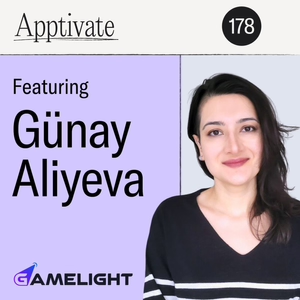
Using AI to advertise mobile games - Günay Aliyeva (Gamelight)
Apptivate: App Marketing Explained
04/03/24 • 27 min
Günay is the co-founder of Gamelight, a user acquisition platform for app developers and a game and app recommendation platform for users. Gamelight’s success can be attributed to its powerful AI algorithm. Learn how UA managers are leveraging tech to pair users with mobile games that they’ll love.
Questions Günay Answered in this Episode:
- How does Gamelight work?
- What technology are you leveraging to run your platform?
- Has Gamelight had this technology from the start?
- What is your background and how did you come to start Gamelight?
- What have you learned from building this AI algorithm?
- How does that change the role of a UA manager?
- What have you seen that works really well for the games that advertise on your platform?
- How do you convince games to advertise on your platform?
- How do you acquire users to your recommendation platform?
- What do you see coming ahead in the industry?
Timestamp:
- 1:53 What is Gamelight?
- 3:27 The AI technology behind Gamelight
- 6:58 Günay’s story
- 9:18 What we’ve learned from building our AI algorithm
- 11:23 The role of the UA manager
- 15:27 What draws publishers to advertise our platform?
- 17:23 How our recommendation platform works
- 21:38 How I become a mobile gamer
- 24:52 What’s ahead
Quotes:
(5:08-5:27) “We let the algorithm decide because it’s way more granular and can analyze more data points than a human. This is how it brings much better UA results for our advertisers because it can pick every single user that could be the best fit for them instead of taking average gender or age for users.”
(13:04-13:13) “[Humans] are more creative. They can have better ideas on what to do and how to plan UA campaigns in a more strategic way.”
Mentioned in this Episode:
Show more best episodes

Show more best episodes
FAQ
How many episodes does Apptivate: App Marketing Explained have?
Apptivate: App Marketing Explained currently has 213 episodes available.
What topics does Apptivate: App Marketing Explained cover?
The podcast is about Marketing, Podcasts, App, Business, Mobile, Apps and Careers.
What is the most popular episode on Apptivate: App Marketing Explained?
The episode title 'The Privacy Saga: Apple v Google - Allison Schiff (AdExchanger)' is the most popular.
What is the average episode length on Apptivate: App Marketing Explained?
The average episode length on Apptivate: App Marketing Explained is 30 minutes.
How often are episodes of Apptivate: App Marketing Explained released?
Episodes of Apptivate: App Marketing Explained are typically released every 7 days, 13 hours.
When was the first episode of Apptivate: App Marketing Explained?
The first episode of Apptivate: App Marketing Explained was released on Nov 13, 2018.
Show more FAQ

Show more FAQ